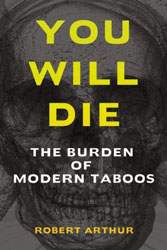Posted: June 19th, 2012 | Filed under: alcohol, bath salts, drugs, media bias | 8 Comments »
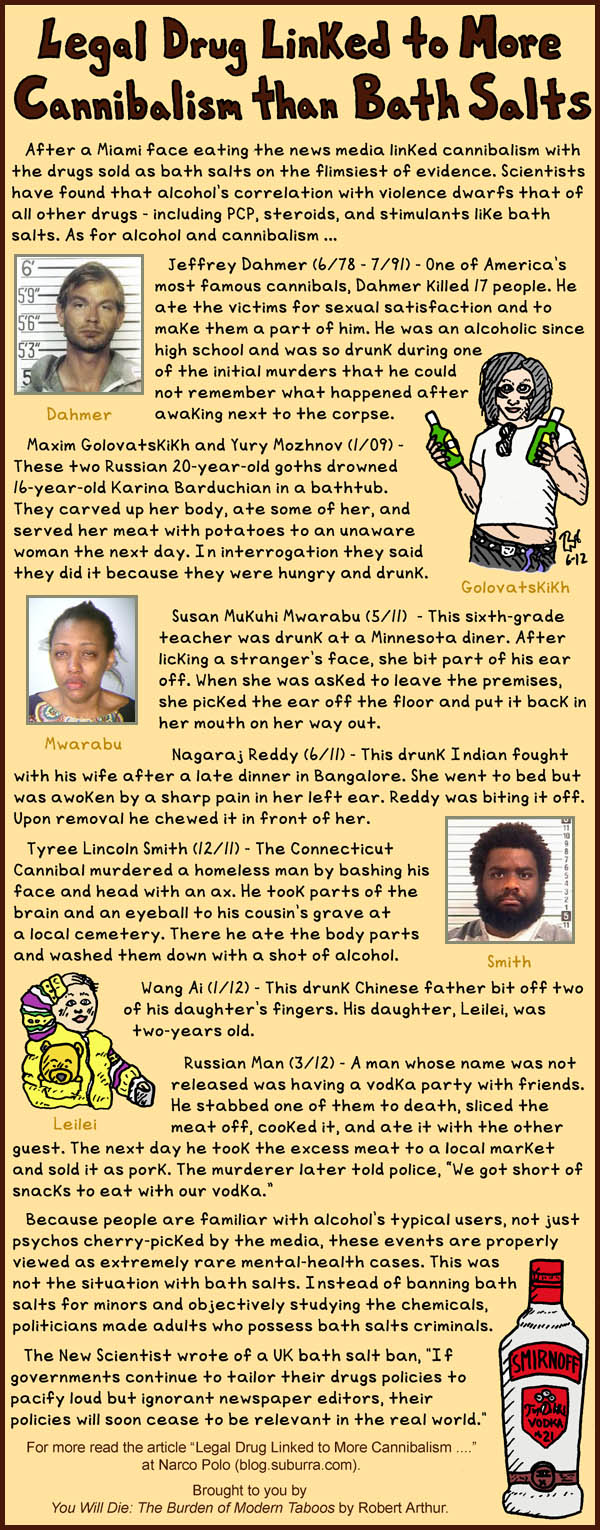
(For more information on bath salts read “Doctor Tried Bath Salts and Liked It: In Defense of Bath Salts.” For an alternate theory of the Causeway Cannibal read “Did Bible Study and Anti-Drug Vow Cause Miami Cannibal Attack?”)
After a face eating the objective news media linked cannibalism with the drugs sold as bath salts on the flimsiest of evidence:
Rudy Eugene (5/26/12) – In the face-eating case, the media continues to link the Miami Causeway Cannibal to bath salts based on the Miami police union chief’s spurious speculation even though initial toxicology reports found no evidence of bath salts in his system.*
Brandon De Leon (6/2/12) – After being arrested for disorderly conduct a homeless Miami man tried to bite an officer and threatened to eat one. A toxicology test found that he had marijuana and Xanax in his system. He was also extremely intoxicated with a blood alcohol content over three times the legal limit for driving (.29). No bath salt chemicals were found by the blood test but news reports say it was “later discovered” that De Leon used the bath salt, Cloud 9.
Carl Jacquneaux (6/5/12) – A Louisiana man, Carl Jacquneaux, bit his neighbor’s face in a fight. The only evidence of a bath salts connection was the victim’s friend said that Jacquneaux used bath salts.
The idiocy of blaming bath salts for violent gore is obvious to the average person who has used these substances. A bath salt, mephedrone, has been one of the top club drugs in the UK for years and has never precipitated cannibalism. (4) Scientists have found that alcohol’s correlation with violence dwarfs that of all other drugs – including PCP, steroids, and stimulants like bath salts. (3) Compare the following acts of cannibalism involving alcohol with the bath salts’ incidents above:
Jeffrey Dahmer (6/78 – 7/91) – One of America’s most famous cannibals, Dahmer killed 17 victims over a 14-year period. He spoke of eating his victims with Dateline NBC in 1994, “It made me feel like they were a permanent part of me …. and it gave me a sexual satisfaction to do that.” (See 20-second clip here.) Dahmer was an alcoholic since high school. He was so drunk during the 1989 murder that launched his spree of savagery that after awaking next to the corpse he could not remember what had happened.
Maxim Golovatskikh and Yury Mozhnov (1/09) – These two Russian 20-year-old goths drowned 16-year-old Karina Barduchian in a St. Petersburg bathtub. They carved up her body, ate some of her, and served her meat with potatoes to an unaware woman the next day. The victim was in love with Golovatskikh, a minor pop star. In interrogation they said they did it because they were hungry and drunk.
Susan Mukuhi Mwarabu (5/11) – This sixth-grade teacher was drunk at a St. Paul, Minnesota diner. After licking a stranger’s face, she bit part of his ear off. When she was asked to leave the premises she picked the ear off the floor and put it back in her mouth on her way out.
Nagaraj Reddy (6/11) – This drunk Indian fought with his wife after a late dinner in Bangalore. She went to bed but was awoken by a sharp pain in her left ear. Her husband was biting it off. She told the police, “He chewed it in front of me. It was disgusting.” (5)
Tyree Lincoln Smith (12/11) – The Connecticut Cannibal murdered a homeless man by bashing his face and head with an ax. He took parts of the brain and an eyeball to his cousin’s grave at a local cemetery. There he ate the body parts and washed them down with a shot of alcohol. He told another cousin that, “he had gotten a rare steak at a restaurant in Florida and when he had tasted the blood it had given him a sexual sensation.” (1) He said the victim’s eyeball tasted like oyster.
Wang Ai (1/12) – This drunk Chinese father bit off two of his daughter’s fingers in China’s Guizhou province. His daughter, Leilei, was two-years old.
Russian Man (3/12) – A man whose name was not released was having a vodka party with friends. He stabbed one of them to death, sliced the meat off, cooked it, and ate it with the other guest. The next day he took the excess meat to a local market and sold it as pork. One of the three purchasers thought the meat tasted strange and took it to experts. The murderer later told police, “We got short of snacks to eat with our vodka.” (2)
Because people are familiar with alcohol’s typical users, not just psychos cherry-picked by the media, the alcohol incidents are properly viewed as extremely rare mental-health cases. Due to yellow journalism responsible bath salts users are invisible. Instead of banning bath salts for minors and objectively studying the chemicals, politicians have responded to the distorted media attention by declaring all adults who possess them criminals.
* Addendum (June 28, 2012) – The full toxicology report of Rudy Eugene released on June 27, 2012 reported that the only drug found in his body was marijuana. The common chemicals in drugs sold as bath salts were absent. LINK
Addendum (July 2, 2012) – On June 26, 2012, a bus driver identified as “Dong” drank heavily at lunch in Wenzhou, China. Whereas his drinking buddies merely passed out, Dong ran into traffic and blocked a woman’s car. He climbed onto the hood and began smashing her windshield. When she exited the vehicle to escape, Dong tackled her and began eating her face. LINK
Sources
1. Martin Barillas, “‘Connecticut Cannibal’ Held on $1 Million Bond,” EnergyPublisher.com, 1 Feb. 2012. LINK
2. Matt Blake, “Russian Man Kills and Eats Drinking Partner ….,” DailyMail.co.uk, 26 Mar. 2012. LINK
3. Martin Brecher, et al., “Phencyclidine and Violence,” J. Clin. Psychopharmacol., Dec. 1988.
4. Jamie Doward, “Mephedrone More Popular Since Being Banned,” Guardian.co.uk, 10 Mar. 2012. LINK
5. “Husband Bites Wife’s Ear in Drunken Rage,” Siasat.com, 4 July 2011. LINK
6. “Politics of Facebook,” New Scientist, 24 Apr. 2010.
Posted: October 5th, 2011 | Filed under: addiction, alcohol, amphetamine, cocaine, drugs, gambling, marijuana, tobacco | 2 Comments »
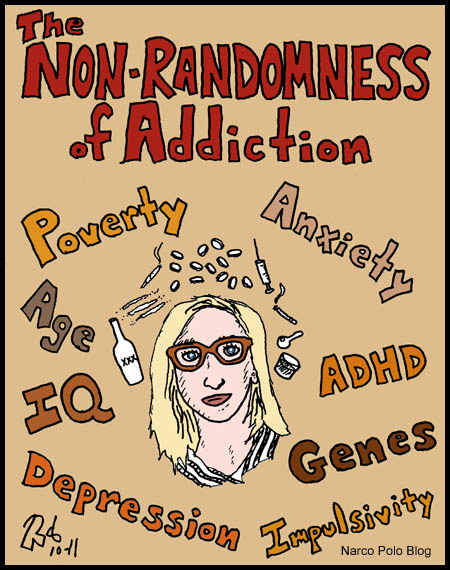
A tenet of the drug war is that drug X is so pleasurable that once tried, most people cannot resist it. There is no way of knowing if you have the “disease” of lifelong addiction to drug X, therefore no one should ever try drug X. All of this is wrong.
The vast majority of people who try drugs do not go on to become addicted (1, 9), and those that do tend to share certain characteristics and conditions. Here are some of the things that predispose people to addiction:
Other Addictions
If a person has not been able to exercise self-control with one source of pleasure, it is more likely he or she will not be able to exercise self-control with another source of pleasure. As can be seen in the following chart, someone diagnosed with a cocaine dependence is 6.64 times more likely than someone without a cocaine dependence to develop a dependence to alcohol.
 (6)
(6)
This overindulgence is not reserved to drugs as demonstrated by the considerable overlap of drug addictions and behavioral addictions. Note that the percentage of the general population that has ever experienced substance use disorders is 14.6%. (5)
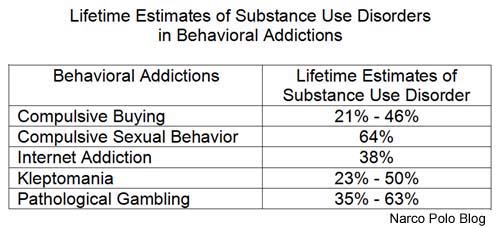 (2)
(2)
Although overlap with food addiction is complicated by drugs’ effects on weight (e.g. cigarettes and stimulants suppress appetites), 32.6% of weight-loss surgery candidates have experienced substance use disorders. (4)
Poverty
Surveys of drinking have long found that despite being more likely to abstain, those from lower socioeconomic groups are still “much more often” problem drinkers. (10, p. 160) A more recent study has found income serves as a predictor for more than just alcohol dependence. As seen below, people in the poorest income bracket are almost three times as likely to become dependent on cocaine as those in the wealthiest bracket.
 (6)
(6)
Mental Health Issues
People with mental health issues are more likely than their peers to become addicted to substances. As can be seen below those diagnosed with ADHD or a personality disorder are three times as likely to become dependent on alcohol.
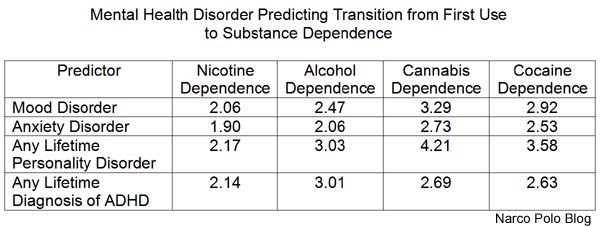 (6)
(6)
Lower Intelligence
Heavy drug users frequently score lower on cognitive tests than their peers. This has been used to say drugs lower intelligence. In the early 2000s two twin studies disproved this idea. In these studies one twin had a history of drug abuse and the other did not. Neither study found a correlation between cognitive performance and amount of drug use. The studied drugs were marijuana, cocaine, and amphetamine. Lower cognitive abilities lead to heavy drug use, not vice versa. (3, pp. 150-152)
Genes
An adoption study has shown that the biological father’s drinking patterns predict a son’s alcoholism, while the adoptive father’s does not. Boys whose biological fathers were severe alcoholics had an alcoholism rate of 18% with an alcoholic adoptive father, 17% with an adoptive home free of parental alcoholism. A study of twins found shared genes did not correlate with experimentation with illicit drugs, but if an identical twin was dependent there was a 40% chance the twin was also dependent. (3, p. 92)
Addictive Personality
People with substance use disorders, just like people with behavioral addictions, score high on self-report measures for sensation-seeking and impulsivity, and low for harm avoidance. (2) This is not surprising. An addict is arguably someone who chooses the sensation an activity provides at levels that are harmful. The choice is influenced by his or her impulsivity, i.e. the tendency to act without weighing the future consequences of one’s actions. The pleasure an addictive behavior provides is immediate whereas the pleasure of moderation is often distant and abstract (e.g. long-term health, more stable work/family life).
Youth
Not only are older people much less likely to become dependent on something, they are also more likely to end dependencies. The vast majority of addicts “mature out” of their addictions and most of them accomplish this without treatment. (11, p. 13) Maturing out is so pervasive that a national 2010 survey found that only .1% of people 65 or older had abused or been dependent on an illegal substance in the past year. The highest level was reached by 19-year-olds (9.3%) from which the number decreased with each ensuing age category. (8)
 (6)
(6)
In line with this, addictive personalities weaken over time. Older adults report being less impulsive, sensation-seeking, and risk tolerant than their younger peers. (12)
Conclusion
Addiction is an intense involvement people fall into for solace when they cannot find better gratifications in the rest of their lives. (11, p. 16) The escape provided by destructive behaviors is usually only appealing to those suffering from internal sources, e.g. mental health issues, or external sources, e.g. poverty. Addiction is a symptom of underlying problems. This helps explain why, contrary to the exhortations of America’s drug warriors, the legal status of drugs has been found to have “surprisingly little measurable consequence” on factors like addiction rates. (7, 3, p. 3) The locus of addiction lies in people, not substances.
Sources
1. Robert Arthur, You Will Die: The Burden of Modern Taboos, 3rd Ed. (2008), p. 330.
2. Jon Grant, et al., “Introduction to Behavioral Addictions,” American Journal of Drug and Alcohol Abuse, 36, 2010.
3. Gene Heyman, Addiction: A Disorder of Choice (2009).
4. Melissa Kalarchian, et al., “Psychiatric Disorders Among Bariatric Surgery Candidates,” American Journal of Psychiatry, Feb. 2007. LINK
5. Ronald Kessler, et al., “Lifetime Prevalence and Age-of-Onset Distributions of DSM-IV Disorders in the National Comorbidity Survey Replication,” Archives of General Psychiatry, 62, 2005.
6. Catalina Lopez-Quintero, et al., “Probability and Predictors of Transition from First Use to Dependence ….,” Drug and Alcohol Dependence, 115, 2011.
7. Robert MacCoun and Peter Reuter, Drug War Heresies (2001), pp. 236-237.
8. “National Survey on Drug Use and Health,” Fig. 5.3B, Substance Abuse and Mental Health Services Administration (SAMHSA), 2010. LINK
9. Frank Owen, No Speed Limit (2007), p. 48.
10. Stanton Peele, Diseasing of America (1995), p. 160.
11. Stanton Peele, Seven Tools to Beat Addiction (2004).
12. D.R. Roalf, et al., “Risk, Reward, and Economic Decision Making in Aging,” Journals of Gerontology, 6 Sep. 2011. LINK
Posted: November 16th, 2009 | Filed under: alcohol, drugs, hallucinogens, heroin, history, legalization, mushrooms, opiates | 12 Comments »
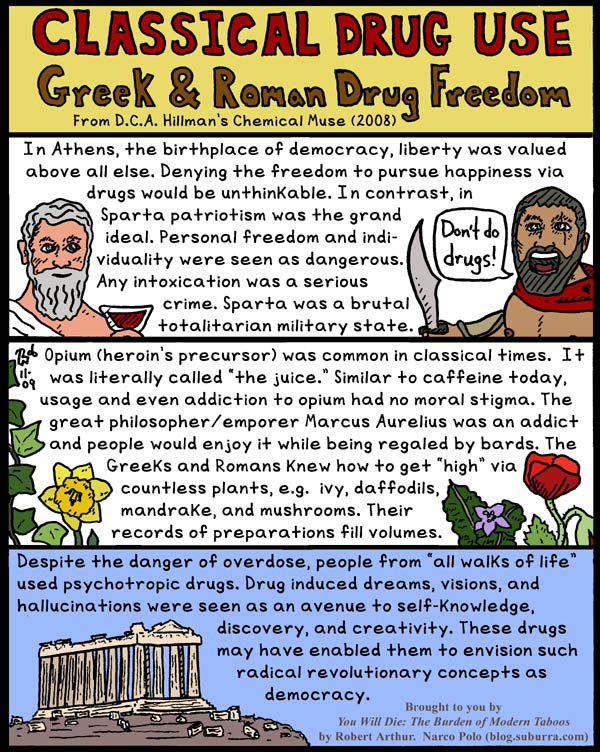
As Dr. David Hillman writes in his book, The Chemical Muse (2008):
The Greeks and Romans used opium, anticholinergics, and numerous botanical toxins to induce states of mental euphoria, create hallucinations, and alter their own consciousness; this is an indisputable fact. (p. 87)
This fact has been intentionally ignored and covered up by historians. (See previous post.) Recreational drugs have been translated out of classical literature in the same manner as bawdy sexual references were until recent decades.
This has occurred with individual words. Opium has been translated into poppy seeds even where it makes no sense. But it has also occurred with entire concepts.
Drugs, Sex, Magic
Classical literature abounds with sorcerers, magicians, and witches. Translators rarely reveal that their power stemmed from their great expertise in drugs. Sorcerers were classical drug dealers and the effects of drugs were seen as magical in those times. Drugs and magic were one.
Medea, the wife of Jason the Argonaut, is frequently portrayed as a witch. She aided Jason by putting fire-breathing bulls asleep and giving him amazing courage. Hillman shows how translators mistranslate polypharmakon and pharmaka to present her as being skilled in the “magical arts” and a possessor of “charms.” Medea was actually “drug-savvy” and possessed “drugs.” She gave the bulls and Jason drugs, not spells.
Sorcerers were honored and respected members of society. They and the more run-of-the-mill drug sellers, “root cutters,” had to know how to extract desired chemicals from plants and animals. This was an exact science for the wrong amount or the wrong extraction could kill. For example, mandrake in minute doses could generate euphoria and stimulate libido, at low doses it was an anesthetic, and at regular doses it was lethal.
Symposia and Spiked Wine
The Greeks and Romans favored method of drug administration was to mix them with wine. This has allowed history teachers to present ancient revelers as merely drinkers – not “illegal drug” users. As the scholar, Dr. Carl A.P. Ruck has written:
Ancient wine, like the wine of most early peoples, did not contain alcohol as its sole inebrient but was ordinarily a variable infusion of herbal toxins in a vinous liquid. Unguents, spices, and herbs, all with recognized psychotropic properties, could be added to the wine. (pp. 176-177)
This gives an entirely different purview of the Greek symposia. At these “riotous drinking parties” great minds like Socrates and Plato debated and developed their theories on the great philosophical questions. Another clue tells even more. Altered states of consciousness were viewed as divinely provided madness. Plato wrote:
But he who without divine madness comes to the doors of the Muses, confident that he will be a good poet by art, meets with no success, and the poetry of the sane man vanishes into nothingness before that of the inspired madmen. (p. 177)
To learn about the academic censorship of this scholarship read, “The Ph.D. Candidate Who Said Too Much: A Drug History Whitewash.”
Source:
D.C.A. Hillman, The Chemical Muse: Drug Use and the Roots of Western Civilization (2008). LINK



 (6)
(6) (2)
(2) (6)
(6) (6)
(6) (6)
(6)
